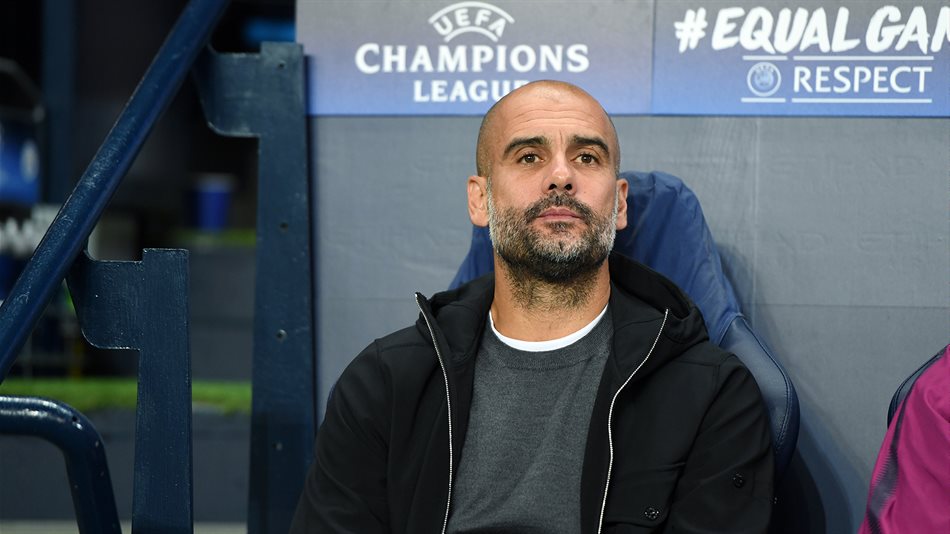Football
Manchester City’s big tactical analysis: analysing four games and individual roles in Guardiola’s system
Manchester City are clearly dominating again after an embarrassing start to the season. They are on a streak of 12 wins in a row in the league, they have scored an incredible 21 goals in their last six and the Premier League seems to be decided compared to pre-season expectations.

Manchester City are clearly dominating again after an embarrassing start to the season. They are on a streak of 12 wins in a row in the league, they have scored an incredible 21 goals in their last six and the Premier League seems to be decided compared to pre-season expectations. With what tactics are Guardiola’s charges achieving these successes in the toughest league in the world?
Newcastle vs. Manchester City | 19. 12. 2021
The first of the four games to be analysed will be the clash between the Citizens and home side Newcastle. The richest team in the world, currently drowning in the relegation zone was run over by the pale blue army 4: 0. The xG stats also spoke strongly in favour of the visitors at 3.71::0.38.
Brief analysis of Newcastle
The Magpies came into the game under still relatively new coach Eddie Howe in a 451/433 formation. The midfield consisted of pure defensive midfielder Hayden, new number eight Joelinton and the most offensive of the three midfielders Willock.
The home side were retracted in a deep block and rarely drew the press. Wilson, the only striker without the ball, covered the defensive midfielder and the Citizens’ stoppers were not much concerned.
When the ball was gained there was a marked effort to cross quickly and attempt to surprise the open Citizens defence. Of Newcastle’s 247 passes, almost half of them went forward. For the visitors, it was only about a quarter.
Wings Fraser and Almiron, after a gain, were quick to go forward to Wilson, forming an attacking trident, which was complemented at the back by Willock. The aim was to catch the stopper duo off guard, who, given the Citizens’ offensive approach to the game, were often left exposed without support when the ball was lost.
Principles of Manchester City’s play against Newcastle
The visitors started in the traditional 433 formation, which gradually changed to 235. Guardiola’s charges mainly used the edges of the pitch to progress the ball, only getting on axis near the sixteen.
The wingers, in this case Mahrez and Sterling, as is their wont, stretched the play as far as they could, while the offensive midfielders De Bruyne and Bernardo Silva pushed into the spaces between the striker and them.
The Blues were very effective on the ball and often got into chances very quickly and fluently. But when it came to conquering, the formation changed to 235 as the two extreme defenders joined the midfield line. This created a triangle between the outside back, winger and offensive midfielder on either side. These trios rotated regularly in both directions.
The variability of the attacking five is also stunning, as they also changed positions like a treadmill. One of the wings will take a dribble towards the axis, the offensive midfielder next to him (operating as a mezzal or false winger) will offer a tandem shot, opening up space for the dribbler.
He continues towards the axis, and so further space is opened up by the forward, who moves to the mezzala position on the side of the dribbling winger. Meanwhile, on the other wing, the back makes a run down the line, the wing opens up space for him and he moves closer to the centerline, replacing the already automatically bouncing mezzala, who replaces the charging backer in the midfield. All of this done at speed with mindless automatism can be deadly to most defenses.
If the ball in the 235 formation has moved to one of the triangles on either side, the stopper has moved out as well, offering an opportunity for a reverse pass. Conversely, Rodri still held the centerline of the field and helped with the quick transfer game.
In order to control the tempo of the game, Manchester City also attacked high in the 442 formation, reacting quickly even when losing the ball.
Most of these principles are often practiced in other Manchester City games. Whenever Formation 235 is mentioned later in the article, it is these rules and principles that are referred to.
Manchester City’s final transition phase against Newcastle
First, we will discuss in detail the already final transition phase that preceded the move to 235. Let’s start with the passing statistics. Everything logically starts from the stoppers, who passed the ball most often between them (Dias 19, Laporte 17 passes), then to the extreme backs on their side (12, 19) and the third most frequent recipient of their passes was the pivot Rodrigo (15, 12).
It is already clear from these statistics that while Dias more often passed the ball to a teammate or to Rodrigo, Laporte tried to move the ball forward through Zinchenko (at this stage the flankers were still in the traditional position at the line), which resulted in a higher percentage of progressions through the left side. But there was a reason for that.
Newcastle’s only attacking player was Wilson, but he was pinned to Rodrigo, whom he tried to nullify with his shadow. This gave stoppers Dias and Laporte plenty of space to advance forward with the ball at their feet. They had to be reached so often by the central midfielders, namely Laporta Willock and Dias Joelinton.
The reason why Dias often returned the ball to the French stopper was also due to the indiscretion of Wilson. The latter often tried to challenge him, but did not turn the trajectory of his run to prevent the just mentioned pass to the other defender. When it went through, Laporte had even more space than he would have had if Wilson had held his ground. Moreover, the English striker was often dragged away from the left-footed stopper by Rodri’s movement.
So Willock had to come out of the block quickly, opening up space for an easy combination. Moreover, the Citizens were heavily outnumbered in such a situation, which led to several simple scenarios to progress the ball (see picture).
The Citizens’ five-man attacking line was also a big problem for Newcastle, creating a constant outnumbering. Each time the Strak defensive back four moved, one winger on the other side was left free with plenty of space to work or dribble one-on-one and then centre.
Manchester City’s passing game against Newcastle
In the game against Newcastle, the features of Guardiola’s charges’ passing were not very evident as they rarely came under the onslaught of the high press. When they did, however, the visitors were helped by Ederson’s excellent kicking technique.
The Stoppers, under high pressure, spread out to the boundaries of the goalmouth, the outside backs spreading out to the edges of the field and stepping higher than you would expect at the breakdown. The two mezzos then pulled up to Rodri’s level and even with Ederson, this created a 3-5-3 formation. Both wingers retreated closer to the winger in these situations (see picture).
This grouping created countless triangles that allowed the home team’s lines to be broken easily. In particular, the trio of Laporte – Ederson – Dias were looking for such passes, and their passes took out several players, allowing the Citizens to go forward.
Newcastle continued to follow a 4-5-1 formation against this lineout. The wingers kept to the outstretched backs, the two more offensive of the trio of midfielders outpaced the mezzos, while Hayden (defensive midfielder) was only just behind Rodri and the leader of the press, Wilson, began to challenge the stopper with the ball.
He then switched to goalkeeper and one of the stoppers was approached by one of Newcastle’s more offensive midfielders. The other stopper was usually left with more space as he wasn’t being approached by another midfielder but rather being closed down by the winger. This pressing wasn’t very effective and City punished any gaps somewhat easily.
This type of play is used by City’s Mancehster on a regular basis. This is also why the passing game is not detailed for other games, it is simply not different.
Manchester City’s pressing against Newcastle
The Citizens’ attacking play is particularly impressive in its players’ ability to quickly switch from the role of attacker to that of defender, which they use especially when gegenpressing after quickly losing the ball. Also admirable is the ability to group quickly and effectively into a formation designed for pressing, the 442.
On the right flank of Jesus, Kevin de Bruyne is in such a grouping, while Bernardo Silva retreats to Rodrigo at No. 8. Manchester City’s pressing is not particularly complicated, but all the more well-rehearsed and effective.
The 442 formation moves compactly all over the pitch and always immediately surges forward when the opposition passes back. Against Newcastle, the press was all the more effective as Willock was often drawn closer to the forwards and the pivot pair of Joelinton and Hayden were easily available.
These two players were personally taken over by Rodri and Silva, with the striker duo putting pressure on the stoppers and the wingers in turn pressuring the outside backs. At the same time, they were trying to make the pitch as tight as possible for the opposition, and when passing to the wings, they were making it smaller by moving to the ball as much as possible.
Another important factor that provided the visitors with control of the game and high possession was the quick press when they lost the ball – gegenpres.
Due to the aforementioned style of play, Manchester City lost most of the balls in the wing areas of the pitch, where they produced the most risky combinations or dribbles. At the same time, it was in these spaces that it most often won the balls, which was possible thanks to the quick reactions of the combination triangles on the sides of the pitch (full-back, mezzala and wing).
This trio on both sides of the field quickly closed down the opponents when they lost the ball and won a lot of balls. Overall, roughly half of all ball dispossessions from the opponent took place in these areas. In the statistics of defensive tackles, the positions of the outside back, mezzala or wing were the most active ones, together with Rodri. This way of attacking when losing the ball also allowed a quick transition to the 442 formation.
Manchester City vs. Leicester City | 26. 12. 2021
Manchester City hosted Leicester on Boxing Day. The match of two completely different halves ended in a 6:3 cannonade in favour of the home team. The xG statistic also favoured the winner with a ratio of 4.00::2.85.
Leicester analysis
Leicester went into the game in a 4231 formation, which transformed into a 4-4-2 when the press came. The aim of the two strikers was to eliminate passes to the Citizens’ pivot, while preventing the stoppers from progressing the ball at their feet as they did against Newcastle.
The wingers often stretched out to the outside backs, which Guardiola then took advantage of to heavily outnumber them in the middle of the park. The four-man defence was also unable to respond to the Citizens’ five-man line, which was in a traditional grouping and left the wingers dangerously too much space.
Up front, the 4-2-3-1 formation was again slightly distorted. Ihenacho was alone at the tip in his role as a classic through-forward and Lookman on the left was operating as a classic winger, unlike Perez. The Spaniard, in contrast, retreated closer to the centre of the pitch and Maddison again closer to the left, forming a quadrangle in the centre of the pitch along with the pair of pivots Tielemans and Dewsbury-Hall.
Albrighton, on the other hand, the right back, on winning the ball, was quick on the right wing, and Thomas, on the left, again assisted with the crossing. As a result, Leicester’s formation went in as 3223 (see picture).
The aim was to ensure better control of the midfield, where the Citizens in a 4-4-2 are not at their strongest, and at the same time to strike from counter-attacks thanks to players with great speed. It was Lookman, Iheanacho and Albrighton (No. 11) who created chances with accurate passes into the forwards from Maddison and Pérez.
The change came in the second half when Perez was replaced by Castagne and the Foxes switched to a five-defender system specifically 541. Wings Maddison and Lookman stayed close to the midfielders and condensed the midfield in a deep block, while Iheanacho defended the pivot Fernandinho.
Forward the formation changed again, this time to 442/244, with Maddison joining Iheanacho on the tip and Albrighton pulling out on the wing again, shifting the entire five-man defence to the right and turning it into a four-man defence with Castagna at right-back.
This formation, in turn, allowed for outnumbering on the fringes, where a winger could run down low and take the Citizens’ outside backs down with him. The attacking pairing thus had spaces to break into the open flanks, which Leicester took advantage of when they scored their first goal.
Manchester City’s play on the ball
The main change from the Newcastle game was the implementation of the false nine. With this, Guardiola reacted to a pair of Leicester strikers whose aim was to disrupt combinations through the middle of the pitch as much as possible. The diamond of central midfielders and Bernardo Silva as a false nine ensured absolute dominance in the middle of the pitch.
In order for Leicester’s low block to have any effect at all, Tielemans and Dewsbury-hall midfielders had to out-muscle the two mezzals they were tasked with defending. The result, therefore, was as many as three players in the spaces between the Foxes’ high-pitched defensive line and the midfield.
This trio therefore kept Leicester’s defenders busy and they had to keep more compactly to the centre of the pitch, offering generous space to the Citizens’ wingers (see picture). The home side’s entire transition phase in the first half therefore quite simply consisted of either combining through the middle of the pitch or getting the ball to one of the wingers as quickly as possible.
The first option depended on the individual qualities and chemistry of the players, which Guardiola’s charges certainly possess. They performed a textbook action on the first goal, when Silva ran between Leicester’s sprawling central midfielders, played the ball to Fernandinho (No. 25), who from the first sent the constantly on the move finisher De Bruyne behind the defence.
The second option again showed the power of the flankers and their positional play in Guardiola’s system. If they stayed near the line, they stretched out the wingers to each other and there was space for a direct pass from the stopper to the winger. If the winger didn’t go to the fullback, two quick one touch passes were enough and just past the edge defender the ball went to the winger.
Another way to move the ball to the wing was to invert the fullback, who retreated to the centre line and joined the back line, which inadvertently pulled the winger towards him, again opening up the possibility for a direct pass from the stopper to the wing.
This option was carried out by the blues much more often than in the duel with Newcastle. Against the team from the north of England Laporte found Sterling with a direct pass once and Dias Mahrez four times, while against the Foxes the French stopper scored twelve such passes and the Portuguese six.
Having thus easily managed to humble Leicester’s defensive lines, the Citizens moved as usual into the 235 formation, already analysed in the analysis of the match with the Magpies.
But Manchester City’s play began to stagnate from the second half onwards. For Leicester, the change of formation brought defensive stability and thickened the midfield spaces. In fact, the entire midfield four was kept in the centre of the pitch, where it was still outnumbered due to the inversion of the Citizens’ backline, but the space was so condensed that it prevented quick and effective combinations.
That’s also why it’s incomprehensible that the home side’s flankers kept trying to walk into the middle and release passes to the wing instead of staying at the line and stretching Leicester’s midfield. Because of the five-man defence, Sterling and Mahrez didn’t have nearly as much space (see picture) and Albrighton and Thomas could afford to get out of position with them.
Brentfotd vs. Manchester City | 29. 12. 2021
Manchester City managed the last game of 2021 as well, beating a resilient Brentford away. Youngster Foden provided the winning goal. Both teams created few big chances, as shown by the xG statistic of 0.36::0.91. From a tactical point of view, the match was interesting, especially because of Manchester City’s new 3-3-4.
Brief analysis of Brentford
Brentford started in a low block in the 532 formation. When pressing, the flankers did not step forward but stuck to Manchester City’s wingers, which contributed to the Bees’ defensive stability. A duo of forwards, supplemented by one of the midfield three, were rarely allowed to press, but there was a lack of compactness.
When playing the ball, Brentford relied on quick counter-attacks or long throw-ins to Toney. The outside backs pulled high in such situations and together with one of the midfielders complemented the Red and Whites’ straightforward attacks.
Manchester City’s play on the ball – the new 3-3-4 system
With the addition of Ake to the starting line-up at left-back, the Citizens’ style of play on the ball has completely changed. Instead of a 4-3-3, the home side operated in a 3-3-4 formation in the final transition phase, then up to a 1-5-4 as the ball progressed forward.
The reason for this change was Brentford’s formation. This was because it left the edges of the pitch completely open defensively and the only players threatening the opening line of defence were the two strikers. It made no sense for Guardiola to play with four in the advanced transition phase, as he did against Newcastle, so he opted for a defensive trio of Aké – Laporte – Dias, who outnumbered the two home strikers.
This gave the two edge-rushers plenty of space to progress the ball, aided by the movement of the second line players. B. Silva – Fernandinho – Cancelo were the main players. This trio was personally defended by Brentford’s opposite three, so they could easily control it.
The far midfielders, i.e. Silva and Cancelo, pulled wide when the ball was in their horizontally split half of the pitch, either freeing themselves or dragging the midfielder with them, thus tearing apart Brentford’s otherwise compact defence. At the same time, this resulted in a 4-on-3 outnumbering on the flanks (see picture).
On the left, for example, Silva and Aké were supported by the more extended Grealish and Foden, forming a quadrangle together. On the right side, De Bruyne and Jesus operated in these spaces. To nullify this Brentford outnumbering, the central defensive midfielder had to withdraw to the edge, which in turn freed Fernandinho.
Another advantage of this system was that Brentford’s centre-half was defending virtually through the air instead of the striker. But he never left his position.
As the ball got forward, the formation changed until 1-5-4, when the two extreme stoppers had already pulled themselves up to Fernandinho’s level. When the ball was on the left, for example, the far midfielder from the opposite side (Cancelo) usually pulled more forward to form an attacking five.
With the pressing and playing without the ball, the formation had already reverted to the classic 4-4-2 with De Bruyne and Foden on the tip.
Notes: The match between Manchester City and Arsenal was not included in the analysis simply because the Citizens system was not sufficiently evident from the match. The match featured many variables and laterally asymmetrical phenomena that would be difficult to summarise in an analysis.
Moreover, after Gabriel was sent off in the 60th minute, the Citizens’ system of the modified new system with three defenders reverted to the traditional 433 of the previous matches against Newcastle and Leicester, hence there was not even enough material to analyse.
Manchester City vs. Chelsea | 15. 1. 2022
For the second time this season, Pep Guardiola has managed to do what he didn’t do even once in the last one. That is, beating Chelsea under German coach Tuchel. At the Etihad Stadium, Manchester City clearly outplayed it, beating the tough London block 1-0 after De Bruyne’s goal.
Brief analysis of Chelsea
Chelsea came out in a traditional 3-4-2-1 formation with Lukaku at the spearhead on whom the whole tactic relied. Without the ball, the team kept a compact 5-4-1 formation. It started with an advanced defensive line, but gradually the system turned into more of a parked bus.
Against Manchester City, who reverted to the system from their games against Newcastle or Leicester, they chose the route they practiced in the Foxes’ successful second half. The four-man midfield line was close together guarding the centre of the pitch and Lukaku was running rather recklessly after the ball in front of them. The outside backs were being attacked on receipt of the ball by either the winger or the outside backs, and the Citizens’ future progress depended highly on it.
With the ball, The Blues played straight forward and tried to hit the opponents with counter attacks, the main aim of which was to get the ball past the charging Lukaku’s defence. When Chelsea managed to get the ball to the opponents’ half by successive crosses, the flankers moved forward and formed a formation of 325, in line with Ziyech, Lukaku and Pulisic.
Manchester City’s play on the ball
Guardiola, after less than convincing performances against Brentford and Arsenal, decided to say goodbye to the new three-defender system for the time being, and with the return of Walker to the line-up, reverted to the good old 4-3-3. At Chelsea, however, he still had to devise a specific plan in which he actually made a weakness out of the Blues’ biggest strength.
And that is the fringe spaces. They are the biggest advantage of the 3-4-2-1/3-4-3 formation. While it languishes in the middle of the pitch, for example, it almost always outnumbers its opponents on the flanks and can use them for both ball progression and high tandem numbers on both the outside and inside.
However, the Spanish coach has figured out how to deal with this system while playing just over the edges of the pitch, which his charges used 80% of the time in the midfield. The key was again the edge defenders, who did not invert, but kept to the sideline.
The two B mezzos. Silva and De Bruyne retreated lower during the advanced transition phase and, along with Rodrigo, kept Chelsea’s withdrawn back four busy. They were occasionally supplemented by Foden, who operated mostly between the lines at the tip. Sometimes as a false nine, sometimes as a classic striker.
This action opened up a lot of space for the outside backs (see picture), who were often able to advance with the ball because of the traditionally stretched wingers holding Chelsea’s outside backs close to them. Thus, when receiving, either the winger would attack them, opening a gap in the middle of the pitch, or the full-back, who in turn would open a gap behind him and leave the wing.
In the case of the first option, the back four usually managed to move quickly and fill the gap or the free player due to the 4-on-3 outnumbering. However, this created an opportunity to transfer the play to the runner on the other side who had even more space or a back pass and a quick combination through the middle, or simply slowing down and looking for another solution.
In the first half, this was successful thanks to many battles won in the middle of the park, where Chelsea’s midfield suffered a lot. So often in such scenarios, it was easy to combine through the middle in a 3 on 3 situation that arose after one winger was taken off.
In the second scenario, where for example Cancelo would go to press Azpilicueta, the Citizens were not afraid to play quick aerial balls to the vacant winger. While this was quickly accessed by the far stopper, in this case Rudiger, even after him a gap was created into which the mezzala, in this case De Bruyne (see picture), quickly rushed.
The striker was also freeing up space for him with his movement, as his run to the touchline pulled the Chelsea centre-half away from the onrushing Bruyne, widening the gap between him and Rudiger even further. In the 24th minute, in this absolutely exemplary fashion, Manchester City went from stopper to opponents’ goalmouth in nine seconds, where De Bruyne finished dangerously.
When Chelsea managed to push on, Manchester City moved back into the 235 formation from their games against Newcastle or Leicester. But it was not easy to get through the reinforced defence, leaving a lot of freedom to De Bruyne or Foden, who often converged laterally to help with combinations in the triangles.
Manchester City’s pressing
Against Chelsea, the way the Citizens pressed changed for the first time in a long time. Instead of a 4-4-2 without the ball, the Citizens formed a 4-2-3-1. Both wings retreated to the striker and pressed the trio of stoppers together. The sub, mostly Kevin De Bruyne, was again in charge of a pair of midfielders.
The aim was to force the stoppers to pass to the wing-backs, who were not personally impeded by anyone. However, on receiving the ball, a midfielder from that side (Rodri or Silva) pressed them and closed him down, whereupon the hitherto more withdrawn full-back and winger also pressed him (see picture).
Analysis of the different roles in Guardiola’s system
To conclude this analysis, we will look in detail at specific roles in Guardiola’s system. For all of them, we will also discuss the individual attributes that Citizens scouting focuses on in the respective positions.
Goalkeeper
The requirements for this position are fairly simple and almost traditional in modern football. Citizens goalkeepers are involved in the midfield, so great footwork is required. At the same time, they must have speed and be able to run quickly when passing behind a stretched defensive line.
Catching for Manchester City is challenging especially because of the low workload even against strong teams. It is all the more important to make just one save per game, which Ederson did brilliantly against Chelsea, for example, when he saved Lukaku on a breakaway with the score still 0:0.
The outside back
This position is always key in Guardiola’s teams. Most of the time, it is the full-backs who determine the style of play in each game. It is necessary to have such a high understanding of the game and the system, to know when to invert and when to stay at the line instead or when to move fully into the 2-3-5 formation already and when to stay more patient.
Apart from game intelligence, the technical side and playmaking is also important for the outside backs. They are often more like midfielders than traditional fullbacks. Explosiveness and the ability to quickly switch between roles and return to their original position is also important. Kyle Walker completely excels in this area, while Liverpool’s Alexander Arnold is often criticised for this in a similar position.
Stoper
If you want to succeed at the highest level, it is simply necessary to have a footballing stopper. Especially in Manchester they are keen on highly technical stoppers with not only good passing but also ball management. At the same time, it is important to have a left-back on the left and vice versa.
Due to the high pressing, speed is also needed as they often get into one-on-one speed battles when the opponents counterattack. Height or jump is also indispensable, as it is difficult to get through the Citizens’ press other than with long kicks.
Defensive midfielder
Both technical and physical prowess are needed at this position. During the game, this player usually distributes the most passes after the stoppers, he is also one of the most accurate passers. He must be able to play well under pressure with players on his back and be able to dribble his way out of such situations.
At the same time, he also needs to be able to pull the brakes on a counter-attack and not be afraid to make sharper interventions.
Offensive midfielders (mezzaly)
Players in this position must have the attributes of classic offensive midfielders, i.e. playmaking or shooting from distance. However, they should also be able to rotate at the wing or false nine position due to frequent rotations. Also important is the technique of centred balls, which these players often get to in the spaces in between.
A high level of work rate is also needed, as they operate very high when playing with the ball and run a long distance when backchecking during a match.
Wings
The most important are the classic attributes in wingers. Agility and dribbling, but also first touch in long passing plays. Especially in one-on-one battles and subsequent centres, wingers like Sterling or Mahrez are absolute extras.
A striker + would Schick fit into the system?
It’s safe to say there isn’t a single striker in the current squad. Jesus has already moved more to the wing, and the spike comes mostly as an alternative, given the game tactics. Sometimes you need a pure false nine who is more part of the midfield and so has great technique or playmaking.
But sometimes you also need a spike striker who has quality interplay but especially excels at space selection and productivity. In this respect, Patrik Schick is associated with Manchester City and he fulfils these attributes. Moreover, he has also become accustomed to physically demanding football in the Bundesliga in terms of pressing.
However, we probably wouldn’t see him in the starting line-up every weekend, as the false nine is definitely not his post and he doesn’t meet the demanding requirements of the Citizens on the wing either. So we would probably see him against weaker opponents or from the bench.
Whoscored, Total Football Analysis (data), SofaScore












